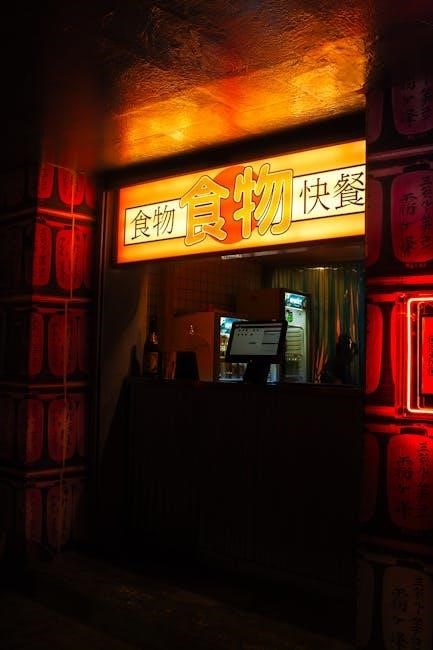Restaurant Terminology: A Comprehensive Guide
Every industry possesses its own unique vocabulary. This comprehensive guide unlocks essential restaurant terminology. From front-of-house interactions to back-of-house operations, understanding the lingo enhances communication and efficiency, ultimately improving the guest experience.
The restaurant industry, a vibrant and dynamic sector, thrives on efficient communication. To navigate this fast-paced environment, understanding restaurant lingo is crucial. This guide serves as a comprehensive introduction to the terminology used daily in restaurants, covering various aspects of the business from culinary arts to customer service. Whether you’re a seasoned professional or new to the scene, mastering the industry’s specific language will enhance your ability to contribute effectively and provide exceptional experiences. Learning the terminology of restaurants ensures smooth operations and better understanding of food and beverage.
This introduction covers the fundamental terms that you need to know to break into the restaurant industry.
This guide helps to improve communication, efficiency, and overall success in the culinary world.
Front of House Terminology
The “front of house” encompasses all areas where guests interact directly with staff. Mastering front-of-house terminology is essential for creating a welcoming and efficient dining experience. From the moment a guest enters to the moment they leave, clear communication is key. This section delves into the specific terms used by servers, hosts, and other front-of-house staff to manage seating, take orders, and ensure guest satisfaction. Familiarity with these terms enhances teamwork and promotes a seamless service flow. These commonly used terms help create a customer-friendly enviornment. It also includes important interaction terms and also table management and seating terms. The front of house creates the first impression.
Understanding the terminology is very important to ensure that guests have a great experience.
These definitions will make sure that there is no breakdown in communication.
Server and Guest Interaction Terms
Effective communication between servers and guests is paramount for a positive dining experience. This section highlights essential terms used during service. Understanding terms like “86’d” (item is unavailable), “comped” (item is free), or “on the fly” (urgent request) allows servers to quickly address guest needs. When communicating, servers can also use terms such as “cover”, which indicates the number of guests at a table. Servers should also know what “American service” is. Good knowledge of these terms is very important to ensure a great customer experience. Also know the basics such as refills or specials. Also, understanding dietary needs is a must.

This allows servers to provide efficient and attentive service, creating a welcoming atmosphere.
These terms are crucial for accurate order taking and managing guest expectations, leading to increased satisfaction.
Table Management and Seating Terms
Efficient table management is essential for maximizing seating capacity and ensuring smooth restaurant operations. The following terms are fundamental for hosts and seating staff. “Open table” signifies an available table, while “on deck” indicates a party is next in line. “Campers” are guests who linger longer than expected, and need to be kindly encouraged to leave. The term “cover” refers to the number of guests seated at a table. Knowledge of these terms is essential for seating guests. It is also a good idea to rotate tables. This will allow you to maximise the number of customers you serve. Don’t forget about customers with reservations either.
Understanding “rotation” ensures fair distribution of tables among servers.
These terms help streamline the seating process, minimize wait times, and optimize restaurant flow, enhancing overall efficiency and customer satisfaction during peak hours.
Back of House Terminology
The back of house (BOH) encompasses all areas unseen by guests, primarily the kitchen. Clear communication is paramount for efficient BOH operations. “Mise en place,” a French term, means “everything in its place,” referring to ingredient preparation. The “Chef de Cuisine” is the head chef, overseeing all kitchen activities. “Line cooks” work specific stations, like grill or sauté. “Expeditor” coordinates food orders, ensuring accuracy and timeliness. “Walk-in” refers to the large refrigerator. “86’d” means an item is unavailable.
Understanding these terms promotes smooth workflow, minimizes errors, and ensures consistent food quality. Teamwork is essential in the back of house and knowing these terms will help.
Effective communication in the BOH contributes significantly to overall restaurant success and customer satisfaction.
Culinary Terms and Definitions
The culinary world is full of specialized terms. “Al dente,” borrowed from Italian, describes pasta cooked to be firm to the bite. “Julienne” refers to cutting vegetables into thin, matchstick-like strips. “Braising” is a slow-cooking method using both moist and dry heat. “Sautéing” involves cooking food quickly in a small amount of fat. “Macerate” means to soak food in liquid to soften it or infuse it with flavor. “Emulsify” is to combine two liquids that normally don’t mix, such as oil and vinegar. “Reduce” means to simmer a liquid to concentrate its flavor by evaporation.
Mastering these definitions ensures precise cooking techniques and consistent dish preparation. These terms are used internationally in culinary settings.
A strong understanding of these terms is essential for any chef or cook.
Kitchen Operations and Staff Roles
Efficient kitchen operations rely on clear communication and defined staff roles. The “chef de cuisine” leads the kitchen, overseeing all aspects of food preparation. “Sous chefs” assist the head chef and manage specific stations. “Line cooks” are responsible for preparing dishes on their assigned stations, such as the grill or sauté station. “Dishwashers” maintain cleanliness, ensuring a steady supply of clean dishes and utensils. “Expediters” act as the communication hub, relaying orders from the front of house to the kitchen. “Prep cooks” handle preliminary food preparation tasks, such as chopping vegetables and portioning ingredients. “Kitchen managers” oversee inventory, ordering, and cost control.
A well-defined structure ensures smooth workflow and consistent food quality.
Menu Terminology
Understanding menu terminology is crucial for both staff and customers. A well-crafted menu uses specific terms to describe dishes accurately and enticingly. “Entrée” typically refers to the main course, while “appetizer” denotes a smaller dish served before the main course. “Amuse-bouche” is a complimentary bite-sized offering from the chef. “Garnish” refers to the decorative element that enhances the presentation of a dish. “Crudo” describes raw seafood that is dressed with oil, citrus, and seasonings. “Consommé” is a clarified broth that is often served as a soup. “Mise en place” refers to the preparation and organization of ingredients before cooking. A detailed menu provides guests with clear expectations.
It also ensures staff can accurately describe dishes.
À la Carte vs. Table d’Hôte
Two common menu styles are à la carte and table d’hôte. À la carte menus offer individually priced items, allowing diners to customize their meal by selecting each course separately. This provides flexibility but can be more expensive. Conversely, table d’hôte (also known as a prix fixe menu) presents a complete meal at a fixed price. This often includes a set number of courses, such as an appetizer, main course, and dessert, with limited choices within each course. Table d’hôte menus offer value and streamline service. Diners should understand the difference to make informed decisions.
Menu selection depends on budget and preference.
The chef usually designs the table d’hôte.
Dish Descriptions and Ingredients
Menu descriptions should entice diners while accurately representing the dish. Clarity is key, avoiding overly flowery language that can mislead guests. Highlight key ingredients, preparation methods (e.g., grilled, sautéed), and any prominent flavors or sauces. Accurate allergen information is crucial for guest safety. Be specific about potential allergens like nuts, dairy, or gluten. Ingredient sourcing, such as “locally sourced” or “organic,” can appeal to certain customers. Clearly state portion sizes or approximate weights when relevant. Use descriptive adjectives that accurately convey the dish’s character without exaggeration. Well-written descriptions enhance the dining experience and manage expectations.
Consider cultural sensitivity when naming dishes.
Keep it concise and straightforward!

Financial and Operational Terms
Understanding financial and operational terms is crucial for restaurant success. “Prime cost” refers to the total cost of goods sold plus labor expenses. “Gross profit” is revenue minus the cost of goods sold, indicating profitability before operating expenses. “Net profit” represents the final profit after all expenses are deducted. “Inventory turnover” measures how quickly inventory is sold and replaced. “Food cost percentage” calculates the portion of revenue spent on food. “Labor cost percentage” tracks the portion of revenue spent on labor. “Breakeven point” is the sales level needed to cover all costs. Analyzing these metrics informs pricing strategies, cost control measures, and overall financial health. Efficient operations rely on understanding these terms to optimize resource allocation and maximize profitability.
Cost Control and Inventory
Effective cost control and inventory management are vital for a restaurant’s financial health. “FIFO,” or First In, First Out, ensures older inventory is used first to minimize spoilage. “Par level” refers to the ideal amount of each ingredient to have on hand. “Inventory turnover rate” measures how quickly a restaurant sells and replenishes its stock, indicating efficiency. “Waste reduction” strategies minimize food waste through careful portioning and storage. “Yield percentage” calculates the usable amount of an ingredient after preparation. “Standard recipes” ensure consistent ingredient usage and portion sizes. “Costing cards” detail the exact cost of each dish. By implementing these practices, restaurants can optimize inventory levels, reduce waste, control costs, and maximize profitability, ultimately ensuring a sustainable and successful business operation.
Covers and Revenue Metrics
“Covers” represent the number of guests served in a restaurant, a fundamental metric for tracking business volume. “Average check” calculates the average amount spent per guest, providing insights into spending habits. “Revenue per available seat hour (RevPASH)” measures revenue generated per seat during operating hours, indicating efficiency in utilizing seating capacity. “Table turnover rate” reflects how many times a table is occupied during a specific period. “Prime cost” encompasses the total cost of goods sold and labor, a key indicator of profitability. “Gross profit margin” represents the percentage of revenue remaining after deducting the cost of goods sold. “Break-even point” identifies the sales volume needed to cover all costs. Monitoring these metrics enables restaurants to optimize pricing strategies, staffing levels, and operational efficiency, ultimately driving revenue growth and maximizing profitability in a competitive market.
Marketing and Customer Service Terminology
Effective marketing and customer service are crucial for restaurant success. “Call-to-action (CTA)” prompts immediate customer response, like “Order Now!” “Customer Lifetime Value (CLTV)” predicts a customer’s total spending during their relationship with the restaurant. “Net Promoter Score (NPS)” gauges customer loyalty through the likelihood of recommending the restaurant. “Search Engine Optimization (SEO)” enhances online visibility. “Social Media Marketing (SMM)” utilizes platforms to engage with customers and promote offerings. “Email Marketing” delivers targeted messages to subscribers. “Remarketing” re-engages past website visitors. “Mystery Shopper” provides unbiased feedback on service quality. “Customer Relationship Management (CRM)” manages customer interactions and data. “Service Recovery” addresses complaints effectively to retain customers. These strategies, combined with attentive service and genuine hospitality, build lasting customer relationships and brand loyalty, ultimately driving repeat business and positive word-of-mouth referrals in a competitive market.
Promotions and Special Offers

Understanding common promotion types is vital for attracting customers. “Happy Hour” offers discounted drinks and appetizers during specific times. “Prix Fixe” provides a multi-course meal at a set price. “Early Bird Specials” incentivize early dining with reduced prices. “Two-for-One” deals offer a free item with a purchase. “Loyalty Programs” reward repeat customers with points or discounts. “Limited-Time Offers (LTOs)” create urgency with temporary deals. “Bundling” combines multiple items at a lower price than individual purchase. “Upselling” encourages customers to purchase more expensive items or upgrades. “Cross-selling” suggests complementary items to enhance the order. “Daily Specials” feature unique dishes at discounted rates. “Themed Nights” attract customers with specific cuisine or entertainment. Strategic use of promotions and special offers can boost sales, attract new customers, and increase customer loyalty, contributing to overall restaurant profitability.
Guest Experience and Feedback
“Table Touch”: Server check-in to ensure satisfaction. “Comp”: Complimentary item for service recovery. “86’d”: Item unavailable, communicate promptly. “Allergy Alert”: Critical to prevent reactions. “Dietary Restriction”: Accommodate needs with alternatives; “Comment Card”: Collect guest feedback. “Online Review”: Monitor reputation on platforms. “Mystery Shopper”: Anonymous evaluation of service. “Net Promoter Score (NPS)”: Measures loyalty via survey. “Service Recovery”: Address complaints effectively. “Guest Relations”: Build rapport and resolve issues. “Customer Lifetime Value (CLTV)”: Predict future revenue. “Personalization”: Tailor service to preferences. “Empathy”: Understand guest perspectives. “Proactive Service”: Anticipate needs. “Feedback Loop”: Act on feedback for improvement. “Zero Moment of Truth (ZMOT)”: Online research before visiting. Managing guest experience and feedback is crucial for building loyalty and maintaining a positive reputation, directly impacting restaurant success.
Food Safety and Hygiene Terminology

“FIFO (First In, First Out)”: Rotate stock to prevent spoilage. “HACCP (Hazard Analysis and Critical Control Points)”: System for identifying and controlling food safety hazards. “Cross-Contamination”: Transfer of bacteria between foods. “Temperature Danger Zone”: 40°F-140°F, where bacteria thrive. “ServSafe”: Food safety training and certification. “Sanitize”: Reduce pathogens to safe levels. “Clean”: Remove visible dirt and debris. “Foodborne Illness”: Sickness caused by contaminated food. “Allergen Awareness”: Knowledge of common food allergens. “Handwashing”: Essential for preventing contamination. “Personal Hygiene”: Maintaining cleanliness to prevent spreading germs. “Pest Control”: Preventing and eliminating pests. “Material Safety Data Sheet (MSDS)”: Information on hazardous chemicals. “Corrective Action”: Steps taken to address food safety issues. “Recall”: Removal of unsafe food products from the market. Maintaining strict food safety and hygiene standards is paramount to protect customers and uphold the restaurant’s reputation, preventing potential health hazards and legal repercussions.
